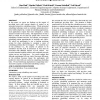Free Online Productivity Tools
i2Speak
i2Symbol
i2OCR
iTex2Img
iWeb2Print
iWeb2Shot
i2Type
iPdf2Split
iPdf2Merge
i2Bopomofo
i2Arabic
i2Style
i2Image
i2PDF
iLatex2Rtf
Sci2ools
ACMDIS
2010
ACM
2010
ACM
Incorporating user control in automated interactive scheduling systems
In this paper, we report our findings on the impact of providing users with varying degrees of control in an automated interactive scheduling system. While automated scheduling techniques such as constraint optimization have been widely adopted in a variety of scheduling applications, such applications require that users relinquish a certain amount of control to the system. The implications of such a shift in control are not clear for people who oversee the scheduling of human activities, for example, case managers scheduling patient appointments in hospitals and clinics. We asked our participants to use a working prototype system for clinic scheduling to complete a series of scheduling problems that we designed. We varied the size of the problems--i.e., the number of patients to be scheduled--and the style of interaction in ways that are associated with different degrees of user control. We recorded standard usability metrics and conducted post-task written surveys and interviews. Ou...
ACMDIS 2010 | Clinic Scheduling | Human Computer Interaction | Interactive Scheduling | User Control |
| Added | 05 Dec 2010 |
| Updated | 05 Dec 2010 |
| Type | Conference |
| Year | 2010 |
| Where | ACMDIS |
| Authors | Jina Huh, Martha E. Pollack, Hadi Katebi, Karem A. Sakallah, Ned Kirsch |
Comments (0)

